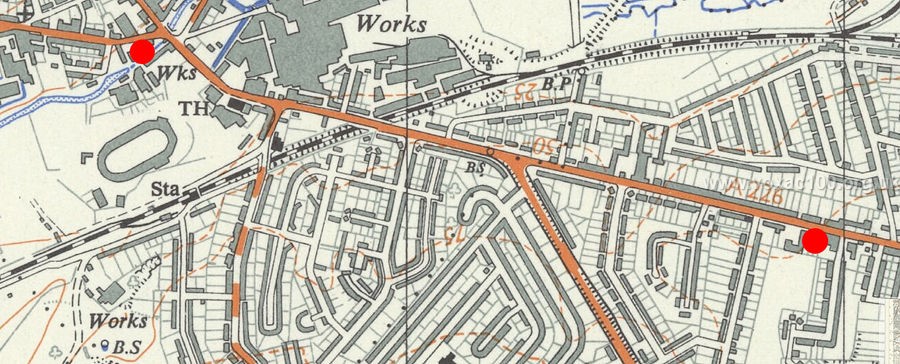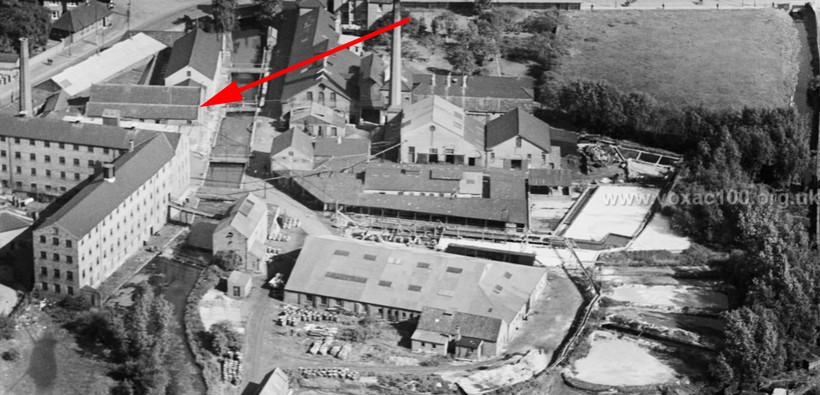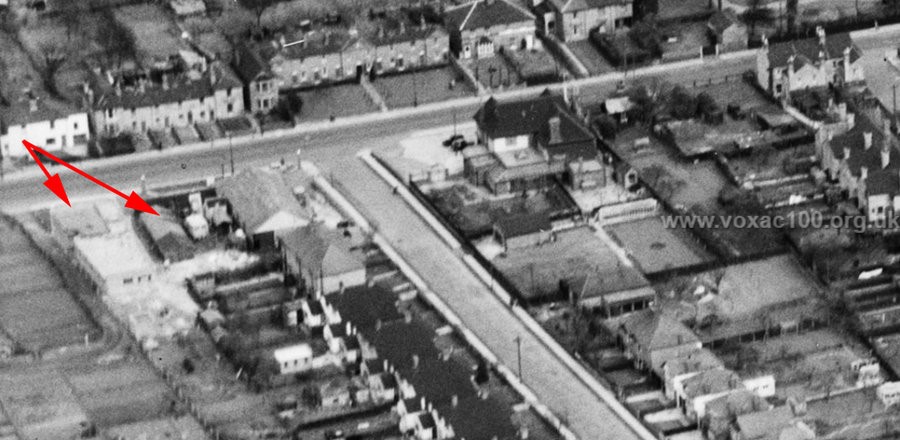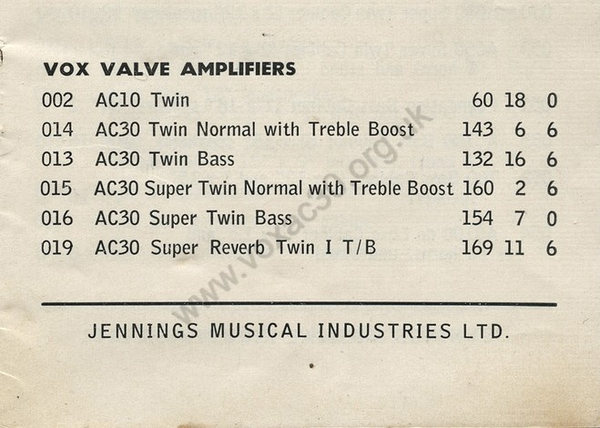Vox AC30 website updates
July 2020
31st July
A further note on black panel AC30/4s and AC30/6s. At first, all were assembled at 115 Dartford Road. The bending and stamping of the metalwork was contracted out to Burnham Engineering (Burnham Road, Dartford); wooden cabinets came from Glock in Crayford (as noted below); and components were bought in from a variety of suppliers - Haddon, Radiospares, WIMA and so on.
With the advent of the "new" AC30/6 - changes listed in May 1961 - assembly of AC30/6 was farmed out to Westrex in North London. AC30/4s continued to be assembled at Dartford Road until early winter 1961, when they were phased out.
Splitting off assembly of the AC30/6 around May '61 will have simplified production considerably.
30th July (2)
AC30 serial number 14625, late summer / early autumn 1964 now registered on this page. Thanks to John for the pictures.
30th July
Allan Billington, an accomplished accordionist, was the first manager of the new Jennings shop at 100 Charing Cross Road (from December 1950). In 1956 he left to set up business for himself in Welling (Kent), remaining there well into the 1970s.
"Melody Maker" magazine, 5th September, 1964. Two AC30s in stock.
The shop and his van. Picture from the Bexley photo archive.
The shop label on a Farfisa organ. Thanks to Simon for the pic.
29th July (2)
The entry for JMI in the manufacturers section of "Who's Who in Music", 1962. 88 Broadway, Bexleyheath, was "Musicland", sometimes called "Paul's Music Studio", run by Tom Jennings's son Paul.
29th July
In the foreground of the photo below, the Westrex works, 150-152 Coles Green Road, Dollis Hill, North London, pictured in 1930. The building under construction in the background on the North Circular (the main road) is Kemp's Biscuit Factory.
Chassis assembled for JMI at Westrex will have been be driven to Dartford by van.
The Westrex works, 150-152 Coles Green Road, Dollis Hill, North London.
28th July (3)
Details of the Haddon choke on an AC30 chassis (assembled by Westrex) from late 1962 or early 1963.
28th July (2)
Some notes on contractors and the assembly of AC30s in late 1961 and 1962.
BURNDEPT. There are three principal indicators that an AC30 chassis was assembled by Burndept.
(1) A stamped serial number in front of output transformer. The sequence began at 01000. By around 02000 the number was stamped instead underneath the voltage selector.
(2) The use of white Erie resistors. The silver strip indicating tolerance (+/- 10% of the marked value) is generally at the top.
(3) The use of Woden transformers with green shrouds bearing the date code of manufacture. The earliest known are from late summer 1962.
The earliest AC30 chassis to possess all three characteristics are from the autumn of 1962, beginning with serial numbers in the 5600s.
WESTREX. Four principal indicators, but in this case one negative.
(1) No serial numbers stamped on the chassis.
(2) The use of Albion or Haddon transformers.
(3) The use of brown Dubilier resistors, normally with tolerance band at top.
(4) Red dye on the solder joints, dabbed on at the final inspection to mark that the joints were good.
Detail of serial number 6038 showing brown Dubilier resistors.
The earliest amplifier to exhibit all four indicators is serial number 5225, the next earliest, insofar as pictures are available, serial number 6038. A fairly sizeable number of amplifiers, however, bear only three of the four principal signs of Westrex manufacture - (1), (2) and (4). Instead of Dubilier resistors one finds white Eries. The amps in view include late black panel AC30/6s.
The question is then whether all AC30 chassis in the serial number range 4600 (or thereabouts) to around 5600 were assembled by Westrex. Taking the presence of red dye on the solder joints to be a definitive indicator, the answer must be for the most part yes. Whether small runs of chassis were assembled from time to time at 115 Dartford Road (the "Works") during this period - the second half of 1961 to mid 1962 - as they were in earlier years (i.e. up to mid 1961), is not known at present.
Final assembly at any rate did take place there - the fitting of chassis and speakers into cabinets, the provision of serial number plates and vents, the fitting of carrying handles, and so on. The main cabinet maker for early AC30s was P.A.Glock in Crayford, only a mile or so up the road from the Jennings works. Below, some notes on Glock from the AC100 website.
Up to 1954, the business was based in Belvedere, Erith. Prompted by the need for more space, Glock moved in that year to 1b London Road, Crayford, just over a mile up the road from the Jennings works on Dartford Road. The company remained in Crayford until 1991.
The red dots mark the respective positions of the P.A.Glock works in Crayford (top left), and the Jennings works on Dartford Road (lower right).
1b London Road, marked as "Factory". A little to the north were the Crayford Saw Mills.
1b London Road, Crayford, photographed from the air in 1934 (i.e. twenty years before Glock moved there).
28th July
Just to signal that a page on the Jennings Musical Industries works at 115-119 Dartford Road is now available on the Vox AC100 website.
The next entry to be posted here, coming soon, will be on AC30s built in the Dartford Road factory in 1961 and early 1962.
An aerial shot of Dartford Road taken in 1953. Number 115, formed of two adjoining parts (one behind a screen wall), is indicated by the arrows. To its right is the garage on the corner. At the time the photograph was taken, number 115 was an Estate Agents. The buildings were acquired by Jennings by 1958 at the latest, becoming the works (factory), also known as "Unity House".
27th July (2)
A note on early grey panels. Burndept (contracted by Vox to assemble chassis) was certainly provided with batches during the course of 1964 - possibly using them fairly systematically for short runs interspersed between larger runs of amps with copper panels. But that remains to be substantiated.
The lowest chassis number to have been fitted with a grey panel seems, at present, to be number 04476 (Super Twin, with serial number 2901).
Taking things the other way round, the lowest serial number so far to have a grey panel is 12019 (chassis number 04690).
As the details below show, early panels are visibly different from later ones. Note how the letters "JMI", which are smaller early on, sit against the background.
Serial number 12019. Chassis number 04690. Assembled by Burndept.
A standard later grey panel.
27th July
"Melody Maker" magazine, 2nd February, 1963, Vox advert principally to advertise the AC10 Reverb Twin. Note the new-style stand, fully tubular construction, lugs to retain the speaker cabinet or amplifier - both the same width - front and back. But it is mighty peculiar that the AC10 amplifier section pictured does not fit the stand properly. Clearly some sort of error somewhere.
The small panel, lower right, gives a snapshot of amplifier prices at the time. The T60 bass has become for this ad at least the "A.C.60 Transonic Bass".
"Melody Maker" magazine, 2nd February, 1963.
23rd July
The "Miami Herald", 12th December, 1965. The AC30 ("Vox Viscount") is $530.00, equivalent at the time to around £182 10s 0d. JMI list price in the UK was £143 6s 6d, swivel side stands a further £9 9s 0d.
In the USA in late 1965 $330 would buy one a Fender Tremolux, and $480 a Fender Twin Reverb. The AC30 was therefore a comparatively expensive option.
"Miami Herald", 12th December, 1965. The Royal Guardsman is the AC50, but the set-up represented is highly anachronistic.
22nd July
A couple more small ads from 1965 in connection with the new page on documents 1965. Both were posted in "Melody Maker" magazine by Pan Music, the first in late June '65, the second in mid July. Pan was above the famous (or infamous, depending on one's view) Flamingo Jazz Club on Wardour Street. Given the number of AC30s advertised, it seems likely that the shop/business had some arrangement with JMI. Most of the amps offered (and sold) were well below the standard retail price.
"Melody Maker" magazine, 26th June, 1965. Twenty AC30s in stock.
"Melody Maker" magazine, 10th July, 1965. Note the fawn Super Twin at £80, and the fawn standard Twin at £45. Oh for those days.
21st July (2)
Below, five of the six JMI Bulletins as they appeared in "Banjo, Mandolin and Guitar" magazine, January to May 1958. These differ in order (and content) from the Bulletins published in "Melody Maker" magazine in the first half of the year. The prices cited differ too.
See for instance the Bulletins on the page devoted to the AC2/30, late 1957 to Spring 1958.
The BMG and Melody Maker "Bulletins" will form part of a forthcoming early documents page.
January 1958.
February 1958.
March 1958.
April 1958.
May 1958.
21st July
Two new pages are now in progress, one on the perspex AC30s made for Trade Shows, the "British Musical Instrument Industries Trade" (annually in late August), and the "Frankfurt Musikmesse" (annually late April or early May) being the most important for JMI; the other page is documents 1965.
19th July
The Thomas Organ pocket reference guide of late 1965 / early 1966. This was in some respects the precursor of the service manual sheets issued for individual amps in mid 1966. Specimen pages below. The booklet as a whole is available here.
Spare parts - transformers and so on - will have been shipped by JMI to the main Thomas Organ complex in Sepulveda.
18th July (2)
Below, details from the JMI pricelist of November 1965. Nine formats of AC30 are available, along with three types of stand, and the Top Boost add on unit. One could also buy Super Twin amplifier and cabinet sections separately - four types of Super Twin amplifier.
In the USA it was only possible to buy Super Twins as a set - amp and cab were not offered individually.
18th July
Below, the AC30 (a.k.a the "Viscount") in the three earliest Thomas Organ Vox catalogues with illustrations.
The "Million Dollar Sound" catalogue, late 1964 / early 1965. A copy of the catalogue can be seen in a photograph published in April 1965. The AC30 is still the AC30.
The "King of the Beat" catalogue, autumn 1965. The AC30 is now the "Viscount".
The "British Sound" catalogue, early 1966.
17th July (3)
The Vox retail pricelist of April 1967 - AC30s in six formats, along with separate sections and covers.
17th July (2)
The page on early Super Reverb Twin AC30s has been updated with pictures of two amplifiers belonging to the early numerical sequence - numbers 7785 (posted last month lower down this page) and 10956, which has just come to light.
A new page on the trapezoidal AC30 SRTs - serial numbers in the 3500s to 5600s (approximately) - will be set up soon.
17th July
The page on the single speaker AC/30 has been expanded. The limiting factor in terms of the power that could be pushed from the two EL34s - the notional "30" watts promoted in advertisements and the amp's name - was of course the single speaker. The same applies to the AC2/30. In the period 1957 to 1960 there were very few 12" speakers that could really handle more than 15 watts. Indeed, 15 watts was the recommended power handling of the two units that JMI regularly fitted - the Goodmans Audiom 60 and the Rola Celestion G12.
The semi-closed backs of the AC2/30 and the AC/30 (perforated fibre-board) naturally gave a measure of protection to the drivers (much as the fully closed back cabs of the Super Twins did later on) - so power handling will probably have been 20 watts or so. The rest was sailing in hope.
Whether the AC/30 actually ran 30 watts into its single speaker is doubtful. Anything much over twenty would really have been testing both the Goodmans and the Celestion to their respective limits.
Denney and Underwood therefore had to tread carefully. In cathode bias a pair of EL34s is capable of producing over 30 watts with ease, and in fixed bias approaching 45 watts (AC50s never made the 50 watts of their name). There was no point in making an amp almost guaranteed to come back with a blown speaker a month after it had been purchased. And remember, that Goodmans noted that the power handling of a speaker when used for bass was around 75% of its stated total - i.e. for a Goodmans Audiom 60, 15 watts for electric guitar and accordion, but around 12 watts for a bass guitar.
14th July
Was the clip of "The Vipers" two entries below the earliest filmed instance of a Vox amp? It seems not by a long chalk. Colin Hicks, who is mentioned as a Vox user in September 1958, features with his band in "Europa di notte" filmed in London, Paris, Rome, Vienna and Madrid, in 1958.
13th July (2)
The programme featuring "The Vipers" - entry below this - was the international show "Europa macht Musik", broadcast from Berlin on New Year's Eve, 1959/1960 - see the IMDB and this listings page.
"The Vipers" had been users of Vox amplifiers since September 1958 at the latest.
"Accordion Times", September 1958.
13th July
Some screengrabs from a performance by "The Vipers", said to be 1959. The aspect ratio has been corrected. In view, perhaps two AC15s, though the one on the left does seem to be a touch larger (a single speaker AC/30?). It is interesting to see the plain grille cloth closely resembles the AC/30 in the promotional photo issued by JMI in 1960. One also finds a similar type of cloth on an AC15 with a serial number in the 3600s though.
AC15 currently in the UK (Blackpool).
The sound quality in the clip below is excellent. The aspect ratio is stretched longitudinally however by a third.
12th July
Below, the well known picture of The Stones with the wreckage of an AC30, destroyed in the riot that broke out during a concert - said to be Blackpool (24th July 1964?). Note that the amplifier chassis has top boost controls in panel.
Albion transformers (the choke ripped away); eight knobs on the control panel.
10th July (2)
Some great new info on a late TV Front amp. Hunts capacitors have the date code "HAY" = 29th week of 1960. One of the pots has the code "CI" = March 1961. Speakers are blue and silver label Goodmans Audiom 60s (15ohms apiece), as in the case of serial number 4414, which is only a few dozen numbers removed from the amp that has recently come to light. Covering is diamond pattern beige vinyl. Transformers are Haddons; the choke made by Radiospares. The original round metal footswitch survives.
10th July
The Stones, backstage, last third of 1963. Brian Jones's amplifier has its serial number plate far left on the backboard, positioned there at factory to make way for the Top Boost cut-out.
9th July (3)
Glen Lambert has set out some fabulous material on the implementation of vibrato (and tremolo) in JMI amplifiers, 1957-1960. The page is here.
A detail of an AC30/4 from the third or last quarter of 1960 showing the extent of the Vibravox circuit (bounded in red).
9th July (2)
A detail from a shot of "The Big Three", support act for The Beatles at the Majestic Ballroom, Finsbury Park, 24th April, 1963. An AC30 (with leather handles) re-grilled in black, and a tray stand with its VOX logo apparently knocked off, leaving a sort of "ghost" of its letters.
If the stand had been borrowed from The Beatles, then its logo will probably have been lost after 12th February, 1963, as it can be seen intact, in relief, in a photo taken in Oldham, evening of that day.
The Big Three, Majestic Ballroom, Finsbury Park, 24th April, 1963.
Detail showing the "ghost" letters.
The Beatles, Astoria Ballroom, Oldham, 12th February, 1963. One can see the VOX logo in relief.
Note that the Big Three's Super Twin amplifier section also at this point had a wholly black grille.
9th July
Original 1960s photos of AC30s in non-standard colours. 1) The amp at left in the picture of The Kinsleys at the Cavern Club in 1964. Beware - the "colour" version of this image is of recent manufacture - i.e. recently "colourised" (and in a fairly generalised way).
Compare the amp to the ones in the pic. (2) of Freddie and the Dreamers, who are known, from original colour photography (1963/1964), to have had AC30s in blue. See this page.
The Kinsleys, 1964.
Freddie and the Dreamers, "Beat Monthly" magazine, April 1964.
8th July (3)
One of a series of pictures to come documenting old and new-style AC30 stands. Below, The Stones in De Lane Lea studio, London, 7th October, 1963. Note that one of the pins retains its rubber protector.
8th July (2)
Pictures of a stand from 1963 with original Kenrick (Shepherd) ball casters still in place, quite scarce these days. Many stands were supplied, however, without wheels. The pins to keep the amp in position, front and back, are fixed only to one surface of the frame, i.e. they do not go all the way through, as in repros.
8th July
A different way of doing stands - screw-in furniture legs. Mike Dee and the Jaywalkers, 1961.
7th July (3)
Further details of The Beatles' AC30 stands, the first picture (with small detail) taken by Dezo Hoffman at the Love Me Do session, Abbey Road, 4th September, 1962; the second a detail of a shot taken at the Cavern Club, January 1963, showing a new-style stand with retaining lugs and a fully tubular construction.
Beatles, "Love Me Do" session, 4th September, 1962. Detail of a photo taken by Dezo Hoffman.
Detail of the above.
The same emblem is found on Vox-branded Reslo ribbon mics.
January 1963, Cavern Club. A new-style stand with retaining lugs at front and back, and a fully tubular construction.
7th July (2)
Detail of one of the Kenrick (Shepherd) casters on an AC30 stand from early 1963. Further shots of the stand to follow shortly.
7th July
Some pics (from 2006) of Super Twin amplifier section serial no. 5204N added here.
Below, one of the earliest illustrated adverts for the new AC30 Super Twin range - new in the winter of 1961. The page is the verso of a flyer issued in late '61 for the new Phantom guitars.
Note that Top Boost is signalled as being a feature in the second paragraph on the left - and probably repeated in the third: "stereophonic tone controls", a fairly loose use of the word "stereophonic". Note the full valance fronts of the speaker cabinets and the black vinyl (as in the shot of Shane Fenton and The Fentones, below).
A detail from the page. The image was regularly repeated in JMI advertising through to 1963.
Vox publicity photo (Reg Clark) published by Jim Elyea. Shane Fenton (later Alvin Stardust) with The Fentones. Note the full valance front AC30 Super Twin speaker cabinets. Note too that the amplifier sections have leather handles. The middle amplifier has its grille cloth "sideways" - the diamonds are horizontal rather than vertical.
6th July
A little more on early stands. JMI evidently provided The Shadows with two tall stands and two smaller ones. Below, the two sets at the NME Poll Winners Concert, 5th March, 1961, one without Cliff, the other with.
Two tall stands, one short.
Two short stands.
A detail of Lennon at the Cavern Club, late August, 1962. One can just see the "VOX" logo on the tray stand of his AC15.
4th July (2)
At least one more TV Front AC30/4 caught in a photograph early on: used by the backing band of "The Allisons" at the "Pop Prom", Albert Hall, 16th September, 1962. The amp at left may be a TV Front AC30 too.
The fronts of both have the name of the band in applied letters - very probably "The Cadillacs" from Portsmouth - see this page.
4th July
Some material on swivel side stands for the forthcoming page on stands. The earliest adverts illustrating AC30s with swivels seem to be those featuring the Dave Clark Five, issued in early 1964.
"Melody Maker" magazine, 1st February, 1964. Note that the amp represented as an AC50 is actually a T60.
"Beat Monthly" magazine, March 1964. There are at least two variant versions of this ad, both featuring the AC30 and stands. The group was resident at the Royal Tottenham (see the panel, lower right in the ad.) from late January to mid February '64. There is good Pathe newsreel footage of one of their performances.
In company with the Dave Clark Five, The Shadows also had swivel side stands relatively early on. Below, pics of an unidentified concert (Paris?) in 1964:
Note that the amp immediately above has top boost controls integrated in the control panel.
The earliest type of hand-wheel had "VOX" in large cursive letters. In the late summer of 1964 the logo was simplified and reduced in size:
First style of hand-wheel design.
There were also two styles of cabinet mount. The earliest had a circular support around the central screw. The other simply had the screw post.
The first picture above is of the earlier type of cabinet mount. The second shows early and later together. Note the later (post mid 1964) form of logo.
Below, pictures of an AC30 from mid 1964 exported to Denmark early on. Note that the remaining (broken) cabinet mount attaches with three rather than four screws.
It may be that these were added later, quite low down, to allow for the extra height of the added wheels. Whether the mounts were supplied by Vox remains to be seen. The other possibility is that they were made by MAX, which produced interesting copies of Vox stands in the mid 1960s.
3rd July (2)
A page of pictures of the amplifier section of serial number 5002N is now available here.
3rd July
Some new entries added on the page for AC30/6s in beige cabinets, serial numbers unknown.
2nd July
Just to give a little more point to a peculiarity of AC30/6 chassis produced in late 1961. Some, if not all, have a "phantom" hole for the rectifier valve, wrongly positioned. AC30/4s do not seem to have it.
In terms of serial numbers, the span is from AC30/6 number 4763 (black panel) to number 5002 (copper panel).
Whether every amp in this range has or had the phantom hole is not known at present. Approaching 250 would be fair number to get wrong. Perhaps it was a particular chassis bender who made only certain batches.
Serial number 4763.
Serial number 5002.
1st July (2)
The page on beige AC30/6s, serial numbers unknown, has now been set up. There are still some amps to add. Details from old ebay auction pages will be supplied where relevant.
1st July
Some updates to the page on AC30s with serial numbers in the 5000s. The amp formerly registered as 4995 is actually 4955, now corrected. Two new amps have been added: numbers 5311, a Super Twin, still with some black WIMA Tropydurs; and number 5356.
The page on beige (fawn, tan, etc) amps, serial numbers unknown, will be available soon.
Updates for June 2020 are now on this page.
Updates for May 2020 are now on this page.
Updates for April 2020 are on this page.
Updates January, February, and March 2020 are on this page .


























































































